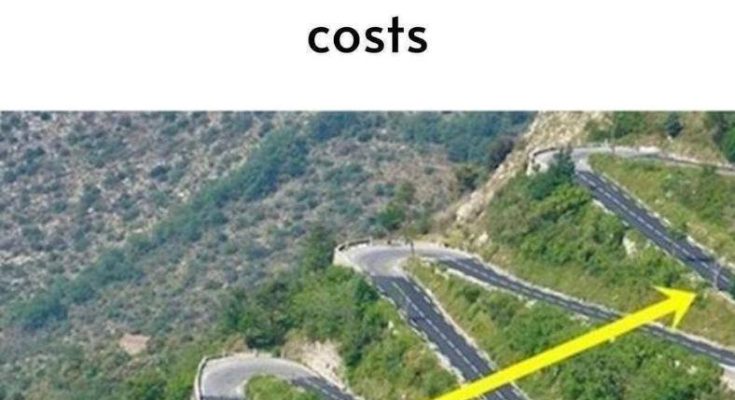When it comes to road construction, especially in mountainous areas, many people wonder why roads aren’t built in a straight line to save time and costs. The shortest distance between two points may be a straight line, but when it comes to road design on steep slopes, practicality and safety take precedence. If you’ve ever driven through mountainous regions, you’ve likely noticed that roads tend to meander and zigzag instead of going directly up the hill. So, why not build it straight up? The answer lies in physics, safety, and engineering principles.
The Importance of Reducing the Gradient
The primary reason for constructing zigzag roads on mountains is to reduce the gradient. Steep roads would be extremely difficult for vehicles, especially heavy ones, to navigate. A straight road going directly up a mountain would result in a steep incline, which could make driving dangerous and challenging. Vehicles climbing at steep angles use more fuel, experience greater wear on their engines and brakes, and put both drivers and passengers at greater risk of accidents.
Zigzag or switchback roads, on the other hand, minimize the slope by extending the road’s length, allowing vehicles to ascend gradually. This approach not only improves safety but also ensures that a wider range of vehicles, including trucks and buses, can navigate these roads without unnecessary strain.
Reducing Speed and Enhancing Control
Building straight roads up a mountain could lead to vehicles gaining excessive speed on the way down. Controlling a vehicle’s descent on a steep slope can be tricky, even with modern braking systems. Zigzag roads serve to slow down traffic naturally, as drivers need to navigate the curves, reducing the risk of dangerous high-speed descents.
By forcing vehicles to slow down and navigate sharp turns, curvy roads also reduce the chances of accidents caused by loss of control. This is particularly important in areas prone to adverse weather conditions, such as heavy rain or snow, where road traction can become poor.
Improved Driver Focus and Reduced Fatigue
Driving straight up a steep road for a prolonged period can be both physically and mentally exhausting for drivers. Maintaining control of the vehicle and managing the incline while traveling a straight path requires constant focus. Drivers are more likely to experience fatigue or distractions, which can significantly increase the risk of accidents.
Curved, zigzag roads break up the monotony of the drive and force drivers to pay close attention as they negotiate each bend. This keeps drivers more engaged and reduces fatigue, ultimately making the drive safer.
Managing Erosion and Environmental Impact
When designing roads, engineers also need to consider the impact on the surrounding environment. A straight road cutting directly through a mountain can cause severe erosion and destabilize the slope. Mountainous terrains are often prone to landslides, and building a road straight up could exacerbate this risk by disturbing the natural drainage patterns and vegetation.
Zigzag roads, by contrast, distribute the load across a larger area, reducing the environmental impact. The construction of switchbacks helps manage water runoff more effectively, which can prevent erosion and landslides. These roads follow the contours of the mountain, blending more harmoniously with the natural landscape.
Maintaining Traction on Inclines
Driving on a steep incline can cause vehicles to lose traction, especially in wet or icy conditions. A straight-up road could present traction issues, particularly for trucks or larger vehicles carrying heavy loads. Without adequate grip, vehicles could slide or stall, leading to dangerous situations for both the driver and others on the road.
Switchback roads minimize the steepness of the incline, making it easier for vehicles to maintain traction as they ascend or descend. This is why hairpin turns are frequently seen on these roads—each turn allows vehicles to gradually change elevation without placing too much strain on their engines or tires.
Historical Precedents and Animal Paths
Historically, roads were often built following the natural paths that animals, particularly donkeys or mules, would take. These animals instinctively avoided steep inclines, preferring to follow paths with more gradual slopes. By observing how these animals navigated mountainous terrain, early road builders could identify the safest and most practical routes for human and vehicle travel.
Even today, modern engineers still consider the lessons learned from nature. A zigzagging path, whether for animals or vehicles, helps to distribute the effort required to ascend or descend and reduces the overall strain on the body—be it human, animal, or mechanical.
Cost Considerations in Road Construction
While it may seem that building a straight road could save on construction costs, the reality is often the opposite. Straight roads on steep inclines require significant infrastructure to ensure safety and stability. Retaining walls, drainage systems, and reinforcement are just a few of the additional expenses that would be necessary to prevent landslides and erosion. Zigzag roads, though longer, are often cheaper to build and maintain because they follow the natural topography of the mountain, requiring fewer drastic interventions.
Moreover, the long-term costs of maintaining a steep, straight road are higher due to increased wear and tear on vehicles and the road itself. Frequent repairs, reinforcement, and accident-related costs make zigzag roads the more economical option over time.
Safety Is the Top Priority
At the end of the day, safety is the driving force behind why roads aren’t built straight up mountains. Engineers design roads to minimize risks, ensure accessibility for all types of vehicles, and protect the environment. Straight roads may seem more efficient, but they present significant safety challenges, especially in mountainous regions where weather conditions can change rapidly and where inclines are steep.
Conclusion: The Practicality of Zigzag Roads
Zigzag roads might appear to take the long way around, but they are, in fact, the safest and most practical solution for navigating steep slopes and mountainous terrain. From improving driver focus and safety to managing environmental impacts and reducing construction costs, these winding roads offer a thoughtful balance between efficiency and safety.
So, next time you find yourself on a twisting, scenic mountain road, remember that each curve has been carefully designed to make your journey safer and more manageable. Whether for humans, animals, or machines, sometimes taking the longer path truly is the best route.



